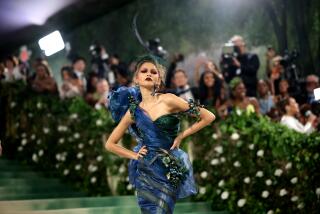China is certainly a big topic
It’s probably fitting that a gallery survey of recent Chinese video art would be far too large to take in fully. So is China. That vast, ancient country’s artists are steadily gaining attention in the wider world, but the tendency to seek a reductive grasp of a hugely complex society and its artistic contours is helpfully upended by a show whose unwieldy form resists it.
At the Morono Kiang Gallery, “Chord Changes in the Megalopolis” brings together video made during the last four years by 12 artists. The combined running time is slightly more than 15 1/2 hours.
Kevin Power, former assistant director of the Reina Sofia National Museum in Madrid and now a university professor, chose the pieces. (A catalog is in the works.) Several are receiving their American premieres. The show is less like a conventional gallery exhibition than like an alternative space presentation. The works are being screened on alternating days in two spaces, although gallery staff is happy to accommodate requests.
On the day I visited, the screenings were Ai Weiwei’s 2004 “Beijing: Chang’an Boulevard” (10 hours, 13 minutes) and a pair of related pieces by Wang Wei: “Dong Ba” (10 minutes) and “Temporary Space” (12 minutes). Needless to say, I watched all of Wang’s two videos and only part of Ai’s.
Ai is among the best-known Chinese artists working now. Having grown up in remote Xinjiang, where his celebrated poet-father, Ai Qin, was exiled during the Cultural Revolution, he lived in New York between 1981 and 1993, when the internationalizing art scene first kicked into high gear. More recently he designed, together with Swiss architects Herzog & de Meuron, the steel-lattice Olympic stadium, nicknamed “the bird’s nest,” being built for next summer’s Beijing Games.
In August, Ai created a stir when he dissociated himself from that project. He decried the “disgusting” political conditions in China’s one-party state in an interview with the English newspaper the Guardian, and he slammed director Steven Spielberg for agreeing to help stage the Olympic ceremonies.
“Beijing: Chang’an Boulevard” is a Minimalist travelogue, mathematically structured and drained of exotic Romanticism. The street splits the city in two along an east-west axis. Ai set up his stationary camera every 250 feet or so along the boulevard’s 28-mile length (even longer than Sunset Boulevard), then shot the urban landscape for one minute. A seemingly endless series of “moving stills,” punctuated by a soundtrack composed of ambient city sounds, the result is an almost anthropological record of daily life.
The duration of each shot allows a viewer just enough time to grasp the rudiments of the scene. A car pulls up, a woman jumps out and quickly disappears behind a low wall -- oh, a subway drop-off. Then it’s on to the next vista -- a park, a filling station, train tracks crossing the highway, soaring apartment blocks, a factory -- in a rhythmic journey that traverses both the densely urban and the seemingly rural.
A gargantuan extrapolation in time and space of Edward Ruscha’s 1966 accordion photo-book, “Every Building on the Sunset Strip,” Ai’s video frames mundane experience with the monumental grandeur of the Great Wall. The paradoxical outcome humanizes a civic reality too big to grasp; even in fragments, “Beijing: Chang’an Boulevard” exudes an unexpected humility.
Wang’s pair of videos is a complementary meditation on time, creation and destruction. Here the mundane and specific become epic and universal.
“Dong Ba” (2003) is a chronicle of workers who salvage bricks from an urban demolition site. Sitting amid piles of rubble, they scrape the bricks clean of mortar, stack them in neat rows and then pile them on a horse-drawn cart. All the material on a fully loaded wagon can be resold, for a princely sum of less than $3.
The wagon arrives at a construction site, where huge cranes spew dust and smoke and the cleaned bricks are recycled into glittering skyscrapers. The startling juxtaposition of labor motifs -- by hand and machine, singular and collective, poverty-stricken and corporate -- makes one wonder about the future, when machinery will be disassembling the once-new buildings and robots might be constructing futuristic, even newer edifices.
“Temporary Space” (2003-07) shows bricklayers building a room inside an existing whitewashed brick room (it looks like an industrial warehouse space -- the kind common to art galleries internationally). The video riffs on the conventional Conceptual art idea of an artist choosing to lock the gallery doors, or empty its contents to exhibit “nothing,” or move the backroom office into the front room display area to explicate commerce.
But Wang, alternating construction footage with black-and-white still photographs of the work in progress, generates a disconcerting sense of laborers imprisoning themselves in their work. At the end, when the room is complete, they get to push down the brick walls.
The destruction looks like fun, even as it evokes the disturbing revolutionary storming of fortress walls. With Wang’s other video playing simultaneously on an opposite wall, China’s strange economic and political conflicts between capitalism and communism slide into view.
Videos by Liu Ding, Xu Zhen, Wang Jian Wei, Chen Chieh-Jen, Dong Jun, Lin Yilin, Yang Zhenzhong, Zhao Liang, Jiang Zhi and Cheng Ran are also being shown.
Morono Kiang Gallery, Bradbury Building, 218 W. 3rd St., L.A., (213) 628-8208, through Nov. 17. Closed Sundays and Mondays. www.moronokiang.com
Work rooted in a rootless world
Peter Rosel, a Berlin-based artist who grew up partly in Morocco and Iraq, has been painting a series of works since 2001 that he calls the Fata Morgana Project. Named after Morgan le Fay, the mythical fairy sister of King Arthur, a fata morgana is a mirage -- the optical displacement of distant objects or the sky caused by bending rays of light.
What could be a gimmick is instead a poignant, poetic organizing device in Rosel’s compelling debut exhibition at Chung King Project. A marvelous triptych is especially fine. Titled on the stretcher bars with the geographic coordinates where Rosel set up his easel in Africa’s Namibian desert, as intense heat jumbled by cool air blowing in off the South Atlantic created regular mirages, the disconcerting works are composed from a wide expanse of pale blues, tans and white.
Each of the three canvases is about 39 inches high and 71 inches wide, which yields a cumulative horizontal landscape nearly 18 feet across. A black man carrying a pickax and dressed in a sweat suit stands at the left side of each otherwise empty panel. With the tool balanced on his shoulder in the first two, he removes his jacket in apparent deference to the heat.
In the third, no longer shown in profile, he turns his back on the viewer and appears to be pointing the pickax toward the horizon. Just where that horizon lies is not easy to discern, since it’s shattered into a shimmering mirage. Distant hills appear to float above the desert floor, as blue sky seeps beneath them to puddle on the earth. As an image of distress -- of a routine urge to locate and anchor oneself in a world determined to slip from empty and chimerical to hostile and tangible -- the juxtaposition of hilly mirage and useless digging tool is seductive and memorable.
Nearby, a quirky figurative sculpture made from barbed wire, a circular saw blade, a plaster-filled balloon, some chunks of concrete and dribbles of resin leans precariously off its pedestal, poised to topple to the ground. But it’s the man in the desert -- either liberated or imperiled -- who seems truly without an anchor. Rosel is his artistic surrogate.
Chung King Project, 936 Chung King Road, Chinatown, (213) 625-1802, through Nov. 24. Closed Sundays through Tuesdays. www.chungkingproject.com
In snow angels, the very essence of art
The neat conceptual trick in Aida Klein’s delightful watercolors comes as much from what she doesn’t paint as from what she does.
For her debut exhibition at the Mary Goldman Gallery, nine modestly sized works show people lying on the ground in snowy landscapes -- men, women and children, usually singly but sometimes in groups. They extend their arms and legs, poised to begin the instantly familiar gesture of making snow angels.
Klein meticulously paints the figures and surrounding trees, fences and buildings in bright, vivid hues, which makes the white snow seem equally brilliant. That the snow is simply the blank, unpainted sheets of paper takes a moment to realize.
But it’s the hinge on which this work swings. Art is conceived as the empty field awaiting human gestures, which embody spiritually minded hopes and playful dreams.
Four small monochrome works depict the negative space of chunky angels left behind in gray-blue painted snow. They form a nice coda to this carefully considered body of work.
Mary Goldman Gallery, 932 Chung King Road, Chinatown, (213) 617-8217, through Dec. 1. Closed Sundays through Tuesdays. www.marygoldman.com
Oh, the horrors of being an artist
The Media Project at Fringe Exhibitions is a rotating basement installation showing video and new media works. In apparent anticipation of Halloween and today’s Day of the Dead, New York artist Matt Marello’s savvy 1999 “The Artist Trilogy” is on view.
Digitally inserting himself into clips from classic schlock-horror movies and a television show, in which artists are portrayed as goofy outsiders, insane murderers and more, Marello manages a deft and witty meditation on popular cultural conceptions.
There’s some serious fun too. In a bit from 1965’s “Dr. Terror’s House of Horrors,” Marello becomes the artist whose hand, severed in a car crash and crawling about like a spider, exacts homicidal revenge on the evil art critic (roguish arch-villain Christopher Lee) who dissed his paintings. It gives new meaning to critical interpretations of “the hand of the artist.”
Fringe Exhibitions, 504 Chung King Court, Chinatown, (213) 613-0160, through Nov. 10. Closed Sundays through Wednesdays. www.fringexhibitions.com
More to Read
The biggest entertainment stories
Get our big stories about Hollywood, film, television, music, arts, culture and more right in your inbox as soon as they publish.
You may occasionally receive promotional content from the Los Angeles Times.







